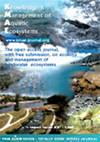Assessing watermilfoil invasion effects on native macrophyte communities in North American lakes using a novel approach for macrophyte sampling
IF 1.7
3区 环境科学与生态学
Q3 FISHERIES
引用次数: 3
Abstract
Aquatic invasive species are among the greatest threats to freshwater biodiversity. The aim of this study was to understand the effects of two invasive watermilfoil species (Myriophyllum heterophyllum Michx. and Myriophyllum spicatum L.) on native macrophyte communities and to assess community response to a range of invasion intensities as well as examine the influence of canopy types. We hypothesized that some communities would be more sensitive to invasion, and that some canopy species would facilitate watermilfoil presence. We used a novel approach to give better representation of the 3D aspect of the community which involved employing a modified quadrat approach to sample at two Connecticut lakes. Results show that watermilfoil invasion has a significant negative effect on native species richness. Floating canopy does not vary with invasion intensity, but submerged canopy does. One species, (Utricularia purpurea Walter), was associated with high native species richness and rarely occurred with invasive species. The results identify potential species that are disproportionally threatened by invasive species, as well as identifying invasion indicator species. The examination of canopy effects is uncommon in aquatic invasion ecology, and this study suggests that this aspect may have significant effects on resilience to invasion and overall community dynamics.用一种新的大型植物采样方法评估水翼入侵对北美湖泊原生大型植物群落的影响
水生入侵物种是淡水生物多样性的最大威胁之一。本研究的目的是了解两种入侵的水叶藻(Myriophyllum heterophyllum Michx)对植物生长的影响。(1)对本地大型植物群落的影响,评估群落对一系列入侵强度的反应,并研究冠层类型的影响。我们假设一些群落对入侵更敏感,一些冠层物种会促进水千箔的存在。我们使用了一种新颖的方法来更好地代表社区的三维方面,其中包括在康涅狄格州的两个湖泊采用改进的样方方法进行采样。结果表明,水黄膜入侵对本地物种丰富度有显著的负面影响。浮冠层不随入侵强度变化,而沉冠层随入侵强度变化。其中一种(Utricularia purpurea Walter)具有较高的本地物种丰富度,很少与入侵物种发生。结果发现了受入侵物种不成比例威胁的潜在物种,并确定了入侵指示物种。对林冠效应的研究在水生入侵生态学中并不常见,本研究表明林冠效应可能对水生入侵的恢复力和群落整体动态具有重要影响。
本文章由计算机程序翻译,如有差异,请以英文原文为准。
求助全文
约1分钟内获得全文
求助全文
来源期刊

Knowledge and Management of Aquatic Ecosystems
环境科学-海洋与淡水生物学
CiteScore
3.70
自引率
5.60%
发文量
22
审稿时长
>12 weeks
期刊介绍:
Knowledge and Management of Aquatic Ecosystems (KMAE-Bulletin Français de la Pêche et de la Pisciculture since 1928) serves as a foundation for scientific advice across the broad spectrum of management and conservation issues related to freshwater ecosystems.
The journal publishes articles, short communications, reviews, comments and replies that contribute to a scientific understanding of freshwater ecosystems and the impact of human activities upon these systems. Its scope includes economic, social, and public administration studies, in so far as they are directly concerned with the management of freshwater ecosystems (e.g. European Water Framework Directive, USA Clean Water Act, Canadian Water Quality Guidelines, …) and prove of general interest to freshwater specialists. Papers on insular freshwater ecosystems and on transitional waters are welcome. KMAE is not a preferred journal for taxonomical, physiological, biological, toxicological studies, unless a clear link to ecological aspects can be established. Articles with a very descriptive content can be accepted if they are part of a broader ecological context.
 求助内容:
求助内容: 应助结果提醒方式:
应助结果提醒方式:


